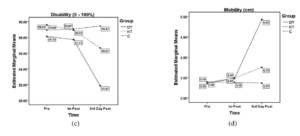Dynamic Tape Global reduces pain and muscle fatigue in those with CLBP – research commentary
Research on ‘Chronic Non-Specific Low Back Pain’ has always been one of my pet hates. Lack of a diagnosis does not a diagnosis make. Subjects within this classification can have wildly different contributing factors. The paper by Martin Rabey, Toby Hall et al from 2017 highlights this. Some may have nociceptive or inflammatory mediated pain while others may have far stronger influence from psychosocial amplifiers. Some may have tissue damage or be on the cusp of it, others may have little evidence of ongoing structural influences and so it goes on. Applying the same intervention to all and expecting an effect is a search for a panacea rather than a clinically reasoned, evidence informed management approach.
It is therefore interesting when a study shows an effect in this sort of group as is the case in the paper by Alhamari et al, published in late 2020. The immediate and short-term effects of dynamic taping on pain, endurance, disability, mobility and kinesiophobia in individuals with chronic non-specific low back pain: A randomized controlled trial.
The results showed that Dynamic Tape Global and Kinesiotape improved pain over the no tape condition. Again, it is hard to discern the mechanism as there is no specific deficit identified that the tape is trying to address. Dynamic Tape Global did however improve spinal mobility and spinal extensor muscle endurance over Kinesiotape and no tape groups. This supports the assertion that Dynamic Tape Global can provide significant force to do some of the work thereby reducing extensor muscle fatigue and possibly aiding in the control of movement through range, exactly what it was designed to do. Whether that has an effect on pain depends entirely on the nature of the pain and tissue damage. If the extensor muscles are a factor in the development of pain e.g. a muscle strain or perhaps due to fatigue then it could be anticipated that the application of Dynamic Tape Global may have a beneficial effect on pain.
There may be benefits in those without ongoing tissue damage but with maladaptive movement patterns, extension dominant splinting and guarding. This paper did show changes to kinesiophobia favouring Dynamic Tape Global but again, a large washout effect would be anticipated as many subjects in the cohort may not have fear of movement. Correctly identifying those who display these movement adaptations and combining the taping application with appropriate pain education may provide further benefit by reducing overwork of the splinting muscles that may be acting as peripheral drivers of pain, while also help to restore movement choice and re-educate more optimal movement patterns and control while reducing the perceived threat. Further, more robust and specific studies are required to evaluate the contribution of each.
Once again, we see that Dynamic Tape Global can effectively introduce force into the system to modify movement or load. Whether that is clinically beneficial depends on correctly identifying a deficit, its relationship to the presenting condition, the mechanisms by which introducing an external force with the tape can address this deficit, correct application and thorough evaluation to determine that a sufficient force was in fact created. Simply taping everyone with pain in a particular region the same way will yield mediocre results. Thorough understanding, assessment, clinical reasoning and application are central to the approach.
The effect over time is interesting in this paper and would support a clinically reasoned hypothesis that by a. doing some of the work of the weak, fatigued, overworked and peripherally sensitised structures that an immediate improvement in pain and endurance would result as observed b. by reducing load, pain and peripheral drive more normal movement can result and this can challenge beliefs around the association between movement, tissue damage and pain, and while a small improvement might occur immediately, this would take more time to manifest (particularly in those with a stronger contribution from psychosocial influencers and amplifiers or central nervous system changes) – as observed in disability, mobility and kinesiophobia. Appropriate preparatory education and instructions consistent with the pain mechanisms identified would potentially enhance this.
While further studies are required with more homogenous subject cohorts and clearly identified deficits/aims/proposed mechanisms, this study provides evidence that Dynamic Tape Global can introduce a force into the system which reduces work of muscle/improves endurance and reduces pain immediately and over time – presumably initially due to reduced load and firing of peripherally sensitised structures and potentially some contribution due to reduced kinesiophobia with these effects building over time due to a dampening down of the system from the top down and bottom up.




